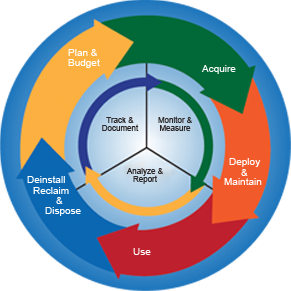

"The cost and complexity of information technology has increased exponentially, including new technologies and delivery models. ITAM, including software asset management (SAM), needs to be a core competency in every organization; it is no longer optional." Sherry Irwin, TAM Inc.
IT Assets: Hardware, software and related services provided by external parties under contracts.
IT Asset Management (ITAM): Integrated inventory, contract, and financial lifecycle practices to minimize costs and risks related to investments in IT assets, and to maximize the value/return of those investments.
TAM Inc.

Technology Asset Management Inc. (TAM Inc.), founded by Sherry Irwin in 1995, specializes in the maturing discipline of IT asset management (ITAM), including software asset management (SAM) and related disciplines of license, contract, and vendor management.
Why IT Asset Management?
Effective management of IT assets, as well as the associated contracts and vendors, ensures maximum benefit from IT investments at minimal cost and with acceptable risk. In our experience, organizations that implement an effective ITAM program will:
- Realize initial savings of 5 to 25 percent of the relevant IT budgets.
- Reduce legal, financial and reputational risk due to non-compliance with contracts, licenses and applicable legislation.
- Increase operational flexibility and responsiveness.
- Increase value from vendors and their solutions through proactive contract and vendor management.
- Increase value from investments in IT assets and services.
- Improve service delivery and client satisfaction.
What is IT Asset Management?
ITAM is an IT business function, in support of managing the fiscal aspects of IT assets,
including financial (cost/value), risk, compliance, contract, and vendor management.
ITAM involves more than tracking the physical (technical) details of IT assets,
although IT asset tracking is an integral part of the ITAM program.
ITAM is complex, with many challenges including:
- It is highly dependent on other functions with accountabilities in the IT asset
lifecycle – within the IT organization, external to the IT organization (e.g., procurement), and, external to the organization. - It requires an integrated view of multiple and interrelated entities – not only
IT assets (as acquired, installed and used) but also licenses, contracts, vendors, financial (budget, spend, taxes, payments, cost recovery), procurement, and organization (people, departments, locations, affiliates, partners etc.). - It requires quality and timely data about each of these entities; cross-system data standards are critical.